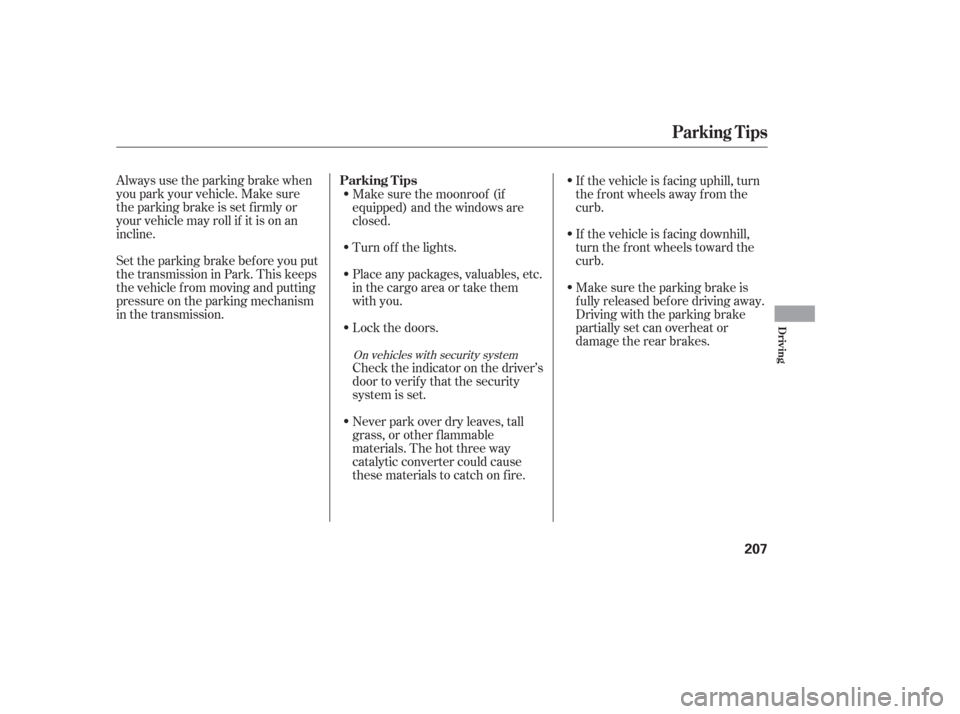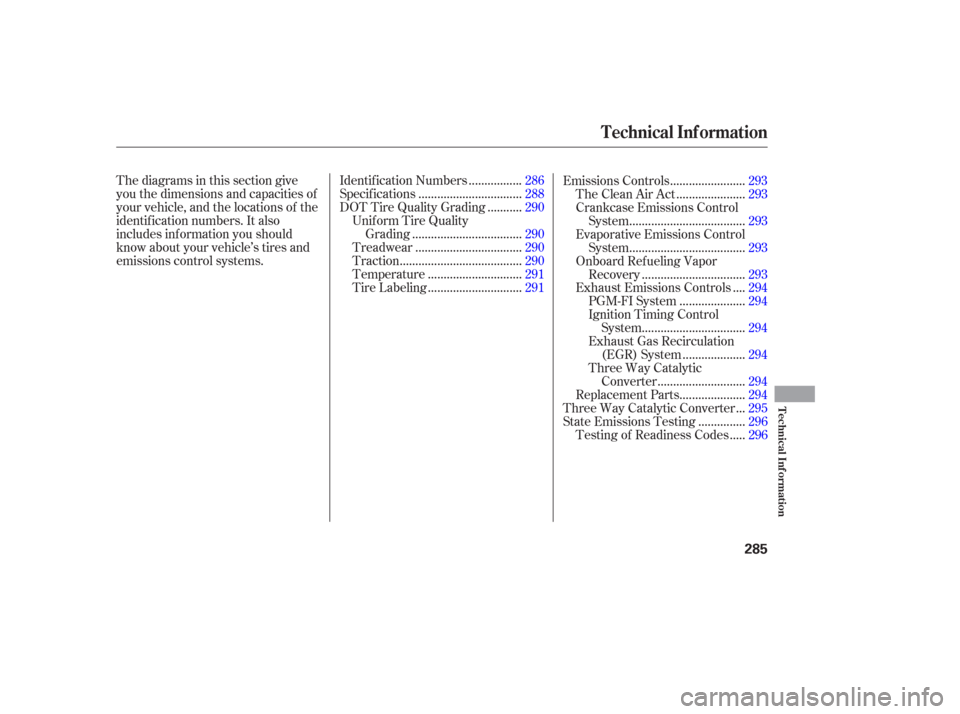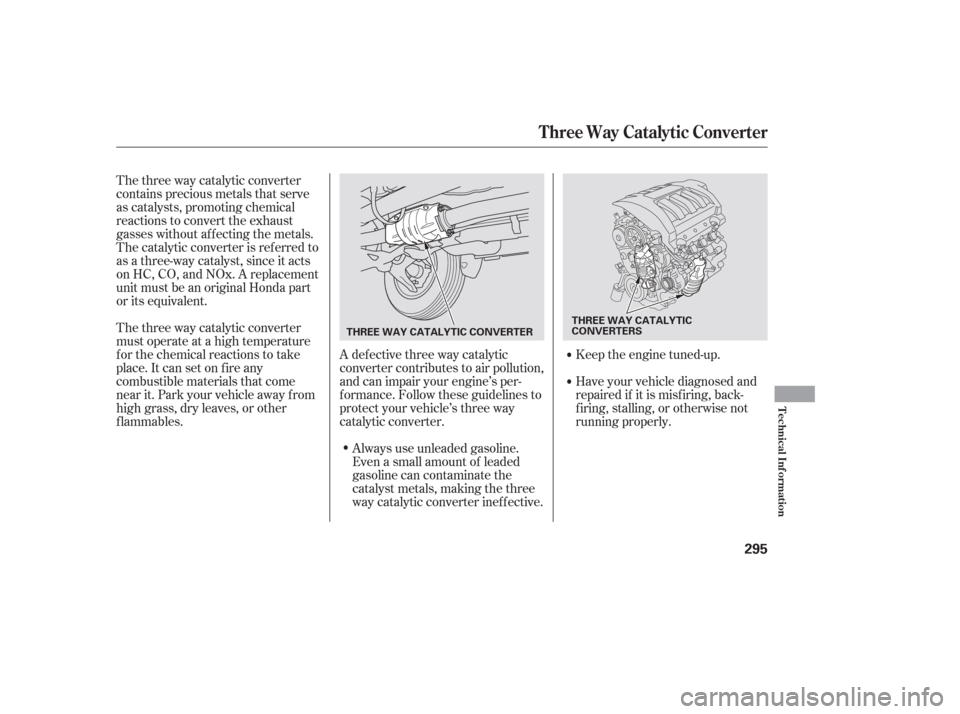2006 HONDA PILOT catalytic converter
[x] Cancel search: catalytic converterPage 72 of 316

Each trip meter works independently,
so you can keep track of two
dif f erent distances.The odometer shows the total
distance your vehicle has been
driven. It measures miles in U.S.
models and kilometers in Canadian
models. It is illegal under U.S.
f ederal law and Canadian provincial
regulations to disconnect, reset, or
alter the odometer with the intent to
change the number of miles or
kilometers indicated.
This meter shows the number of
miles (U.S.) or kilometers (Canada)
driven since you last reset it. This shows how much f uel you have.
It may show slightly more or less
than the actual amount. The needle
returns to the bottom after you turn
of f the ignition.
There are two trip meters: Trip A
and Trip B. Switch between these
displays and the outside temperature
display (except LX models) by
pressing the Select/Reset knob
repeatedly. To reset a trip meter, display it, and
then press and hold the Select/Reset
knob until the number resets to ‘‘0.0’’.
Trip Meter Odometer
Fuel Gauge
Gauges
70
TACHOMETER
SPEEDOMETER FUEL GAUGE TEMPERATURE
GAUGE
TRIP METER
INFORMATION DISPLAY TRIP METER
SELECT/RESET
KNOB
Avoid driving with an extremely low
f uel level. Running out of f uel could
cause the engine to misf ire, damaging
the catalytic converter.
Page 209 of 316

Always use the parking brake when
you park your vehicle. Make sure
the parking brake is set f irmly or
your vehicle may roll if it is on an
incline.
Set the parking brake bef ore you put
the transmission in Park. This keeps
the vehicle from moving and putting
pressure on the parking mechanism
in the transmission.Make sure the parking brake is
f ully released bef ore driving away.
Driving with the parking brake
partially set can overheat or
damage the rear brakes. If the vehicle is f acing downhill,
turn the front wheels toward the
curb. If the vehicle is f acing uphill, turn
the front wheels away from the
curb.
Turn of f the lights.
Place any packages, valuables, etc.
in the cargo area or take them
with you.
Lock the doors.
Check the indicator on the driver’s
door to verify that the security
system is set.
Never park over dry leaves, tall
grass, or other f lammable
materials. The hot three way
catalytic converter could cause
these materials to catch on fire. Make sure the moonroof (if
equipped) and the windows are
closed.
On vehicles with security system
Parking T ips
Parking Tips
Driving
207
Page 287 of 316

Thediagramsinthissectiongive
you the dimensions and capacities of
your vehicle, and the locations of the
identif ication numbers. It also
includes inf ormation you should
know about your vehicle’s tires and
emissions control systems.................
Identif ication Numbers . 286
................................
Specif ications .288
..........
DOT Tire Quality Grading . 290
Unif orm Tire Quality ..................................
Grading .290
.................................
Treadwear .290
......................................
Traction .290
.............................
Temperature .291
.............................
Tire Labeling .291 .......................
Emissions Controls .293
.....................
The Clean Air Act .293
Crankcase Emissions Control ....................................
System .293
Evaporative Emissions Control ....................................
System .293
Onboard Ref ueling Vapor ................................
Recovery .293
...
Exhaust Emissions Controls . 294
....................
PGM-FI System .294
Ignition Timing Control ................................
System .294
Exhaust Gas Recirculation ...................
(EGR) System . 294
Three Way Catalytic ...........................
Converter .294
....................
Replacement Parts . 294
..
Three Way Catalytic Converter . 295
..............
State Emissions Testing . 296
....
Testing of Readiness Codes . 296
T echnical Inf ormation
T echnical Inf ormation
285
Page 296 of 316

The exhaust emissions controls
include f our systems: PGM-FI,
ignition timing control, exhaust gas
recirculation, and three way catalytic
converter. These f our systems work
together to control the engine’s
combustion and minimize the
amount of HC, CO, and NOx that
comes out the tailpipe. The exhaust
emissions control systems are
separate f rom the crankcase and
evaporative emissions control
systems.
The PGM-FI system uses sequential
multiport f uel injection.
It has three subsystems: air intake,
engine control, and f uel control. The
powertrain control module (PCM)
uses various sensors to determine
how much air is going into the
engine. It then controls how much
f uel to inject under all operating
conditions.The emissions control systems are
designed and certif ied to work to-
gether in reducing emissions to
levels that comply with the Clean Air
Act. To make sure the emissions
remain low, you should use only new
Honda replacement parts or their
equivalent f or repairs. Using lower
qualitypartsmayincreasethe
emissions f rom your vehicle.
The emissions control systems are
covered by warranties separate from
the rest of your vehicle. Read your
warranty manual for more informa-
tion.
The three way catalytic converter is
in the exhaust system. Through
chemical reactions, it converts HC,
CO, and NOx in the engine’s exhaust
to carbon dioxide (CO ), nitrogen
(N ), and water vapor. This system constantly adjusts the
ignition timing, reducing the amount
of HC, CO, and NOx produced.
The exhaust gas recirculation (EGR)
system takes some of the exhaust
gas and routes it back into the intake
manif old. Adding exhaust gas to the
air/f uel mixture reduces the amount
of NOx produced when the f uel is
burned.
2
2
Exhaust Emissions Controls Replacement Parts
PGM-FI Syst emT hree Way Cat alyt ic Convert er
Ignit ion T iming Cont rol Syst em
Exhaust Gas Recirculat ion (EGR)Syst em
Emissions Controls
294
Page 297 of 316

The three way catalytic converter
contains precious metals that serve
as catalysts, promoting chemical
reactions to convert the exhaust
gasses without af f ecting the metals.
The catalytic converter is ref erred to
as a three-way catalyst, since it acts
on HC, CO, and NOx. A replacement
unit must be an original Honda part
or its equivalent.
The three way catalytic converter
must operate at a high temperature
for the chemical reactions to take
place. It can set on f ire any
combustible materials that come
near it. Park your vehicle away from
high grass, dry leaves, or other
f lammables.A defective three way catalytic
converter contributes to air pollution,
and can impair your engine’s per-
f ormance. Follow these guidelines to
protect your vehicle’s three way
catalytic converter.
Always use unleaded gasoline.
Even a small amount of leaded
gasoline can contaminate the
catalyst metals, making the three
way catalytic converter inef f ective. Keep the engine tuned-up.
Have your vehicle diagnosed and
repaired if it is misf iring, back-
f iring, stalling, or otherwise not
running properly.
Three Way Catalytic Converter
T echnical Inf ormation
295
THREE WAY CATALYTIC CONVERTER
THREE WAY CATALYTIC
CONVERTERS
Page 313 of 316

CONT INUED
...............................
Signaling Turns .75
.....................................
Snow Tires .260
................................
Sound System .115
Spare Tire ......................................
Inf lating .266
............................
Specif ications .289
....................
Specif ications Charts . 288
................................
Speed Control .175
..........
SRS, Additional Inf ormation . 25
...
Additional Safety Precautions . 37
.............................
Airbag Service .36
How the Side Airbag Of f ........................
Indicator Work .34
..
How the SRS Indicator Works . 33
How Your Front Airbags .........................................
Work .28
...
How Your Side Airbags Work . 31
........................
SRS Components .25
.............................
SRS Indicator .33 ,63
....
START (Ignition Key Position) . 81
.......................
Starting the Engine .199
In Cold Weather at High ..................................
Altitude .199
................
With a Dead Battery . 272
..............
State Emissions Testing . 296
........
Steam Coming f rom Engine . 274Steering Wheel
..................................
Adjustment .78
.............
Anti-theft Column Lock . 81
...............................
Buttons .138, 175
...................
Stereo Sound System . 115
....................
Storing Your Vehicle .263
........................
Sunglasses Holder .100
........................................
Sun Visor .101
Supplemental Restraint System ......................................
Servicing .36
.........................
SRS Indicator .33 ,63
...................
System Components . 25
..................................
Synthetic Oil .240
......
Taillights, Changing Bulbs in . 252
.
Taking Care of the Unexpected . 265
Technical Descriptions ......
DOT Tire Quality Grading . 290
.....
Emissions Control Systems . 293
..........
State Emissions Testing . 296
Three Way Catalytic ...............................
Converter .295
.......................
Temperature Gauge .71
........
Temperature, Inside Sensor . 114....................
Temperature, Outside . 71
...................
Tensioners, Seat Belts . 23
........
Testing of Readiness Codes . 296
..............
Tether Anchorage Points . 51
............................
Thef t Protection .139
..
Three Way Catalytic Converter . 295
..........................
Time, Setting the .140
..................
Tilt the Steering Wheel . 78
....................................
Timing Belt .245
....................................
Tire Chains .261
.........
Tire, How to Change a Flat . 267
Tire Pressure Monitoring ........................
System (TPMS) .205
Index
INDEX
T
VII